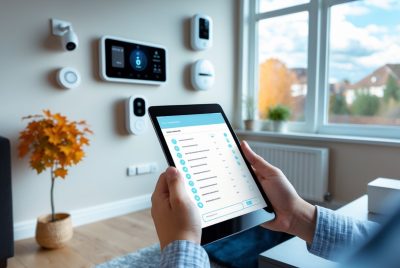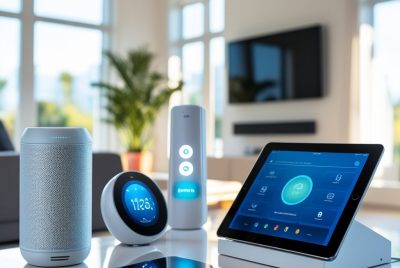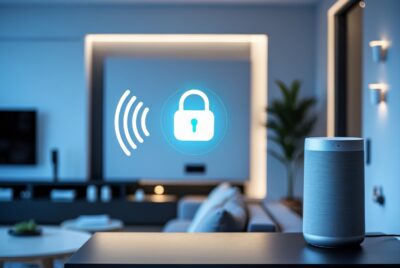Smart Home Wiring: A Comprehensive Guide
*We may earn a commission for purchases made using our links. Please see our disclosure to learn more.
Smart Home Wiring Essentials: Guiding You Through the Basics
Smart home wiring is the backbone of any modern automated household, a critical aspect that I always stress to homeowners looking to transform their living spaces into smart environments. This infrastructure is what enables seamless communication between various devices and the hub that controls them. When I install smart home systems, I make sure that the wiring not only connects and powers the devices but also integrates them into a cohesive network that supports high-speed data transfer and remote operation.

My approach to smart home wiring typically involves laying out a structured cable design that provides both power and data connectivity to stationary devices like televisions, desktop computers, and security systems. I connect these to a central demarcation point, which serves as a link to utility services and allows for easier troubleshooting and upgrades. This setup ensures that the smart systems are not only functional but also scalable, supporting both current technology and future advancements.
To create a smart home that stands the test of time, I carefully select high-quality cables and components that match the technical and energy efficiency requirements of the home’s automation systems. Attention to detail during installation is paramount as it impacts the reliability and performance of smart devices. Whether automating lighting, climate control, or security, the right wiring infrastructure is what makes a smart home responsive and adaptable to the homeowner’s needs.
Understanding Smart Home Basics

Smart home technology transforms my dwelling into a responsive and interactive environment. Embracing automation and connectivity allows me to control various home systems seamlessly, often remotely through a smartphone app. Let’s explore what this entails.
Defining Home Automation and Connectivity
Home automation represents the technological solution allowing the automatic control of common household systems and devices. I utilize this technology to program and schedule a multitude of tasks that smart devices can perform independently or with minimal input from me. Connectivity is the backbone of home automation, encompassing the methods by which devices communicate with one another and with me, often facilitated by a home network and controlled via smartphone apps or voice commands.
Key Features:
- Remote Control: I can manage devices wherever I am.
- Programmable: Set schedules for devices to operate automatically.
- Interoperability: Diverse devices work cohesively together.
- Monitoring: I can oversee device status and receive alerts.
Role of Smart Devices in Home Automation
Smart devices are the components that I integrate into my home to create a smart home setup. These devices have the ability to connect to the internet or other devices, making them operable through a central control system, such as a smartphone or smart home hub. The role of these devices is to provide enhanced functionality, ease, and efficiency within home automation. For example:
- Smart Lights: Allow me to control the lighting remotely or through voice commands.
- Smart Thermostats: Enable me to set climate schedules and adjust house temperature from afar.
Examples of Smart Devices:
- Thermostats
- Lights
- Locks
- Security cameras
- Speakers
By deploying home automation, these devices work in unison to afford me an upgraded level of control over my living environment, leading to not just greater convenience, but also potential energy savings and improved home security.
Planning and Designing Smart Home Wiring

In mapping out smart home wiring, the focus is to establish a robust foundation for connectivity that caters to both current and future technology needs.
Electrical and Network Requirements
I understand that any smart home system hinges on both electrical and network stability. For wiring, this means ensuring that electrical outlets and switches are optimally placed to accommodate devices without overcrowding. A strong network is integral, involving a combination of hardwired Ethernet cables and Wi-Fi connectivity. This dual approach ensures stable internet for smart home devices, with the central router and additional access points strategically located to avoid dead zones.
- Outlets and Switches: Plan for enough outlets near device locations.
- Ethernet: Run Cat6 or higher cables from a central panel to various rooms.
- Wi-Fi: Ensure coverage across the home; consider a mesh network.
Smart Home Wiring for New Construction
When dealing with new homes, I have the opportunity to integrate smart home wiring directly into the construction process. This often involves running neutral wires to all switch locations to support advanced smart switches. Additionally, I ensure that there are numerous Ethernet drops to future-proof against evolving technologies that may require a wired connection for optimal performance.
- Outlet Placement: Install outlets where smart devices will be located.
- Conduit Installation: Use conduits to protect wiring and allow for easy upgrades.
- Central Panel: Include a central panel to manage all wired network connections.
Future-Proofing Your Smart Home Setup
I always consider future-proofing to maintain relevance with technological advancements. This involves allowing for easy updates to the smart home infrastructure and over-provisioning the amount of Ethernet cables, conduits, and general flexibility of the electrical wiring. The goal here is to ensure that my home remains compatible with emerging smart home devices and standards.
- Expandability: Provide extra capacity in panels and conduits.
- Upgrading: Use modular components for easy replacement and upgrades.
- Flexibility: Design wiring with the thought of accommodating unforeseen technologies.
Smart Home Wiring Installation Process

Incorporating smart technology into my home begins with the foundational step of wiring, focusing on precision and safety to ensure a seamless integration of smart devices.
Installing Smart Switches and Outlets
To install smart switches and outlets, my first task is to ensure the power is off at the circuit breaker. After confirming the absence of voltage with a voltage tester, I carefully remove the existing switch or outlet. I must connect the appropriate wires to their matching terminals on the new smart device, which includes a neutral wire—essential for smart switches—and a ground wire which adds safety. Smart outlets typically follow a similar installation process, but adherence to the manufacturer’s specific wiring diagram is vital.
Electrical Safety and Best Practices
Before starting, I prioritize safety by switching off the related circuit at the circuit breaker and using a voltage tester to verify that the power is indeed off. It’s crucial to handle wires with care, wearing protective gloves and eyewear. I aim to keep a neat workspace to avoid clutter that could pose a hazard. If I’m not entirely confident in my electrical skills, consulting or hiring a licensed electrician is a smart choice to prevent costly or dangerous mistakes.
Tools and Materials Needed for Installation
For installation, my toolkit includes:
- Screwdriver: For removing and securing switch plates and switches.
- Wire strippers: To expose the conductive material of wires for a secure connection.
- Voltage tester: To ensure safety by confirming that the wires are not live.
- Drill, with bits and wall anchors: If I need to mount hardware or create new openings.
- Screws and wire nuts: Essential for securing devices and connecting wires, respectively.
Following these processes with the right tools ensures a robust and safe installation of smart wiring in my home.
Integrating Smart Home Technology

Integrating smart home technology enhances the efficiency, security, and entertainment value of my home. Each aspect of smart home integration, from thermostats to security to entertainment systems, needs to be properly linked to create a seamless and intuitive user experience.
Smart Thermostats and HVAC System
Smart Thermostats: I ensure that my smart thermostats are strategically located away from drafty areas to accurately sense the room temperature. Once installed, they connect to my Wi-Fi network, allowing me to adjust settings remotely through a smartphone or voice commands. Proper integration allows my HVAC system to adjust automatically, optimizing energy efficiency and comfort.
- HVAC System Integration: Compatibility between my smart thermostat and existing HVAC system is crucial. I check for features such as:
Feature Description Geofencing Automatically adjusts settings based on my location, ensuring the temperature is ideal when I’m home and energy-saving when I’m away. Learning Ability Learns my preferences and schedules to optimize heating and cooling cycles without my intervention. Alerts Sends timely maintenance alerts and informs me of drastic temperature changes, which can indicate issues with the HVAC system.
Securing Your Home with Smart Technology
Security Cameras: Installing smart cameras around my home’s perimeter and in key interior locations provides me with continuous monitoring. I connect them to a secure home network and check the storage options—whether local or cloud-based—to ensure my data is safe.
- Home Security: With smart locks and smart smoke alarms integrated into my system, I receive real-time alerts on my phone for any security breaches or safety concerns. These devices work cohesively to keep my home protected:
Device Function Smart Locks Allow me to lock and unlock doors remotely and grant access to visitors with time-specific codes. Smart Smoke Alarms Notify me instantly of smoke or carbon monoxide detection, even when I’m not at home.
Entertainment and Smart Home Integration
Audio System: By integrating a multi-room audio system into my smart home network, I control music and other audio across different rooms with a single device.
- Entertainment System: My smart TV, streaming devices, and gaming consoles are linked to my network, enabling voice-command operation and automated routines like dimming the smart lighting when a movie starts.
Device Usage Smart TV Connects to various streaming platforms and adjusts to my viewing habits. Gaming Consoles Sync with my smart home for an immersive experience, like adjusting lights based on game action.
By focusing on these areas, I maximize the advantages of smart home technology, making daily life more convenient and secure.
Optimizing and Troubleshooting Smart Home Systems

As an expert in smart home technology, I’m aware that maintaining optimal performance and quick troubleshooting are vital to a seamless smart home experience. Let’s discuss how to enhance system performance, resolve connectivity issues, and implement cost-effective upgrades.
Enhancing Your Smart Home’s Performance
To ensure speed and efficiency in my smart home, I prioritize the router’s placement centrally. Mesh networks are my go-to for extensive coverage, eliminating dead spots. I regularly update devices and consider adding a dedicated ISP for my home security system, ensuring reliability and reducing the risk of system overloads. For energy efficiency, smart thermostats and LED bulbs are excellent, adapting to my habits and saving on electricity bills.
Diagnosing and Fixing Connectivity Issues
When encountering connectivity problems, my first step is to check the Wi-Fi router and ISP performance. Simple resets often resolve temporary glitches. My troubleshooting checklist includes:
- Confirming all cables are intact and ports functioning.
- Ensuring firmware is up-to-date.
- Verifying that network settings haven’t been altered unexpectedly.
- Testing different channels to avoid interference, especially in crowded Wi-Fi environments.
For persistent issues, I contact my ISP to check for outages or signal problems that might affect speed and reliability.
Cost-Effectiveness and System Upgrades
Upgrading smart home systems shouldn’t break the bank. I compare the cost of potential upgrades against the benefits. An investment in higher-quality electrical work and cabling can offer greater flexibility and scalability for future expansion. Upgrading my router to a more advanced model provides improved speed and connectibility, which directly impacts the convenience and efficiency of my smart ecosystem.
Frequently Asked Questions
In this section, I’ll tackle some of the most common queries users have about smart home wiring, ensuring clarity on components, setup, installations, pre-wiring practices, integration of smart switches, and the advantages of Eplan wiring in the context of home automation.
1. What are the essential components of a smart home wiring diagram?
A smart home wiring diagram typically includes power wiring, data cables (like Cat6 or Cat5e), connections to smart switches, the central smart home panel, and dedicated circuits for heavy-duty smart appliances. It’s a blueprint for where components and devices connect within the home’s electrical and data network.
2. How do I set up a smart home wiring panel to manage my devices?
To set up a smart home wiring panel, you must map all connected devices to the panel and secure appropriate connections for both power and data. Panels are usually accompanied by clear labeling of zones and devices for easy management and future troubleshooting.
3. Can smart home installations be done DIY or is a professional electrician required?
While some smart home installations can be DIY-friendly, like installing smart switches or basic smart appliances, for comprehensive wiring, including dealing with main power circuits, it’s recommended to hire a professional electrician. Safety and adherence to building codes are imperative.
4. What should pre-wiring for a smart home entail to ensure future compatibility?
Pre-wiring a smart home should include running extra conduits and data cables for scalability, considering future smart devices and technology advances. Ensuring that there’s infrastructure for both wired and wireless connections can help keep your smart home compatible with new devices and standards.
5. How do smart electrical switches integrate with home wiring systems?
Smart electrical switches integrate with home wiring by replacing traditional switches, connecting to the house’s electrical wiring, and communicating with the smart home system via Wi-Fi or other protocols. This allows you to control lighting and other connected devices through apps or voice commands.




